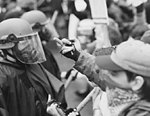THE CROWN JEWEL of civil Seattle—the retail core of big hotels, public-private partnerships, and Planet Hollywood—was transformed. The carless streets were strewn with overturned dumpsters, news boxes, and concrete planters. Each intersection was occupied by the pierced and passionate, many dancing to the rhythms of pounding percussion—drums made of plastic buckets or odd bits of metal. Periodically, a young man with a homemade stovepipe didgeridoo would add the resonant background hum that movie soundtracks use to convince you that something spiritual is about to happen. It was as if Seattle had been conquered by a global tribe of alternative types whose strange rites had yet to be co-opted by frat boys.
And I liked it.
It wasn’t a city sold out, and shut up, by developers. It wasn’t a city too civil to say what was on its mind. It wasn’t a city overrun by consensus. It wasn’t a city showing off its pretty mountains and tasty coffee confections for the cruise ship crowds. It wasn’t a city where the cops, with their new black riot gear and armor, were saying, “Have a nice day.”
This was a city that trashed our unofficial motto, “If you don’t have anything nice to say, don’t say anything at all.”
Often what was said was silly. “Fuck you, Nike” or “Capitalism destroys all life” doesn’t take you very far. But the honesty that comes with a fine rage is a fresh wind, something to clean out the cobwebs of our stale politics and civic discussions.
Yes, I think the smashing and burning sucked. But long before free-floating anarchists and assholes broke windows, looted Starbucks, or set fire to trash cans, many thousands had made their point and accomplished their goal of shutting down the WTO while the world watched. And they did it mostly with clever organization and boundless enthusiasm—and a lot of dancing.
I followed the protesters for eight hours, from the pitch-black pissing rain at Victor Steinbrueck Park to the tear-gassed barricades outside the Sheraton at Sixth and Pike. Their props included giant puppets, turtle costumes, a black-clad marching band called the Infernal Noise Brigade, an inflatable blue whale named Flo, and a Macy’s parade-style blimp from the Rainforest Action folk. Demonstrators were well organized into “affinity groups” and divided, like smokers and nonsmokers, into “arrest” or “not arrest” contingents. One group I ran into was the Reclaiming Cluster, a collection of eco-feminist pagans from the Bay Area.
As the march progressed toward the Convention Center, groups peeled off to block intersections. By the time they reached the Sheraton, the battle for Seattle was in essence already won: For at least a day, downtown was turned into a giant shopping-free zone, and baffled businessmen from all over the world had to take cover.
The police needed tear gas, pepper spray, and hard rubber pellets to dislodge people. I was gassed twice and took cover in a store entryway as pellets ricocheted through the crowd. Next to me was a Mexican journalist who, eyes red and burning, looked at the police action and said, “This is crazy.” We ran, and I found a protester medic to rinse out my eyes.
Seeing clearly, I wandered the streets and watched the crowds, and ran into a friend who summed up the spectacle: “It’s nice to see Seattle behaving badly,” he said.







